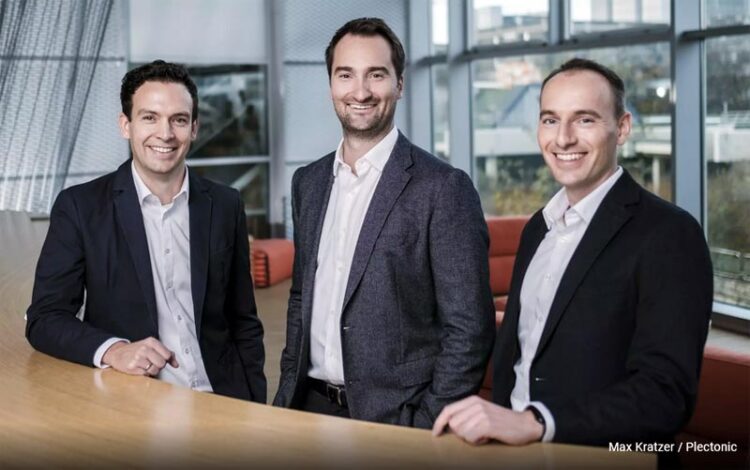Nanoswitches for tumor targeting

Dr. Benjamin Kick, Dr. Klaus Wagenbauer und Dr. Jonas Funke (f.l.) from Plectonic have invented a nano tool for targeting tumors.
Photo: Max Kratzer / Plectonic
SPRIND to finance spin-off Plectonic.
Plectonic Biotech, a spin-off of the Technical University of Munich (TUM), has developed a nanoswitch that binds immune cells to tumor cells. The goal is to facilitate the development of immunotherapies that target tumors specifically and have fewer side effects. The German Federal Agency for Disruptive Innovation SPRIND will provide funding for the work of Plectonic Biotech in the coming years.
Immunotherapies are regarded as one of the most promising approaches to cancer treatment in the future. These treatments mobilize the body’s own immune system to attack cancer cells. An important goal is to achieve high efficacy in the immune response to cancer cells while minimizing side effects. To address this challenge, the Plectonic team, led by founders Dr. Klaus Wagenbauer, Dr. Jonas Funke, Dr. Benjamin Kick and Prof. Hendrik Dietz, has developed an ‘on/off switch’ for antibody immunotherapies.
The structure, on a scale of just a few nanometers, can dock onto cells on two sides. On one side the researchers place antibodies which it can use to identify tumor cells and to bind itself to the tumors. At the same time, this causes a switch to be flipped that activates other antibodies previously hidden on the other side. These are recognized by the body’s own immune cells, which are thus recruited to fight the cancer cells.
Designed with DNA origami technology
“With this technology we can bring together cancer cells and immune cells so that the immune system starts fighting only when a tumor cell is identified. Our goal is to reduce activity on healthy tissue and thus achieve fewer side effects in immunotherapies,” says Klaus Wagenbauer. Different antibodies can be placed on the switch to target various tumor types. Due to the ‘if/then logic’, the team has named the switch the LOGIBODY (LOGIc-gated antiBODY).
The framework of the LOGIBODY is made of DNA. The research team used the extensive experience with DNA origami technology at TUM. The Chair of Biomolecular Nanotechnology has made important contributions to this method, in which DNA is used as a building material for nano-scale tools.
Technologies with potential for disruptive innovation
The start-up now plans to develop new drugs for various tumor-related diseases in collaboration with pharmaceutical companies. The goal of the cooperation between the Federal Agency for Disruptive Innovations (SPRIND) and Plectonic is to carry out studies needed for investigational new drug (IND) registration and to start a clinical Phase 1 study. The funding comes from the Federal Ministry for Education and Research and is provided as a loan.
Mario Brandenburg, Parliamentary Secretary of State for Education and Research and a member of the supervisory board of the Federal Agency for Disruptive Innovations SPRIND, says: “Plectonic, with its breakthrough therapeutic approach, is yet another excellent example of SPRIND’s role in the innovation ecosystem: With SPRIND, we identify and support technologies with potential for disruptive innovation and support them through the ‘valley of death’ from fundamental research to market readiness. Companies like Plectonic Biotech GmbH do not receive sufficient capital from private investors at their level of maturity because drug approval, sales and profits cannot be expected for years and the path to achieving them is risky and cost-intensive. This promising new approach, which is so important for many cancer patients, must have a chance to yield medical and economic benefits in Germany. That is why we need instruments like SPRIND.”
Supported in the TUM Venture Lab
The Plectonic team developed the technology at the Munich Institute of Biomedical Engineering at TUM. Several patent families have already been granted or registered, supported by TUM. The spin-off has received several prestigious funding awards and was promoted by the TUM Venture Lab Healthcare. Each of the TUM Venture Labs specializes in an important technological field.
“The foundation story of Plectonic is emblematic of the successful technology transfer from leading-edge research to applications,” says TUM President Prof. Thomas F. Hofmann. “At TUM we create optimal conditions, from high-tech labs for research to one of the best start-up promotion programs in Europe. A key aspect of these efforts is the entrepreneurial spirit fostered here, which motivates experienced scientists to turn their ideas into market-ready products. As a result, around 70 technology start-ups are launched at TUM every year. The SPRIND funding is proof of their quality.”
Weitere Informationen:
https://www.150.tum.de/en/anniversary-story/dna-origami/ DNA origami
https://www.bioengineering.tum.de/en/ Munich Institute of Biomedical Engineering
https://www.tum.de/en/news-and-events/all-news/press-releases/details/translate-… Entrepreneurship at TUM
Media Contact
All latest news from the category: Life Sciences and Chemistry
Articles and reports from the Life Sciences and chemistry area deal with applied and basic research into modern biology, chemistry and human medicine.
Valuable information can be found on a range of life sciences fields including bacteriology, biochemistry, bionics, bioinformatics, biophysics, biotechnology, genetics, geobotany, human biology, marine biology, microbiology, molecular biology, cellular biology, zoology, bioinorganic chemistry, microchemistry and environmental chemistry.
Newest articles

NASA: Mystery of life’s handedness deepens
The mystery of why life uses molecules with specific orientations has deepened with a NASA-funded discovery that RNA — a key molecule thought to have potentially held the instructions for…

What are the effects of historic lithium mining on water quality?
Study reveals low levels of common contaminants but high levels of other elements in waters associated with an abandoned lithium mine. Lithium ore and mining waste from a historic lithium…

Quantum-inspired design boosts efficiency of heat-to-electricity conversion
Rice engineers take unconventional route to improving thermophotovoltaic systems. Researchers at Rice University have found a new way to improve a key element of thermophotovoltaic (TPV) systems, which convert heat…



